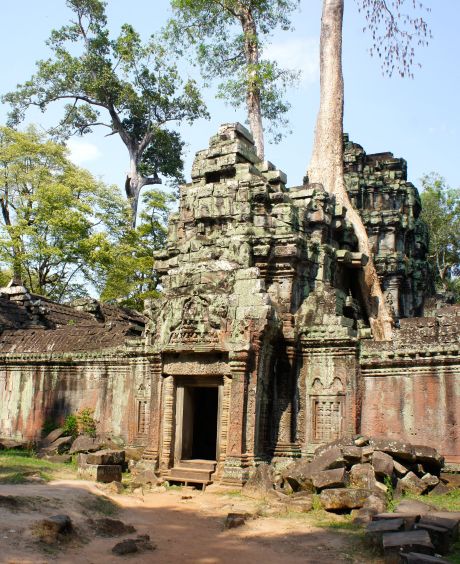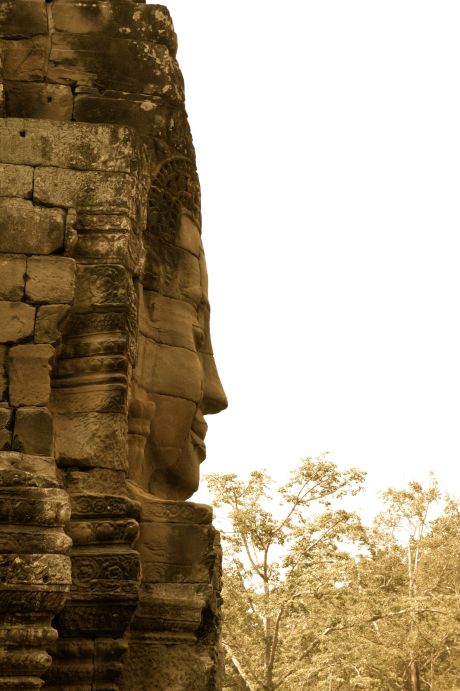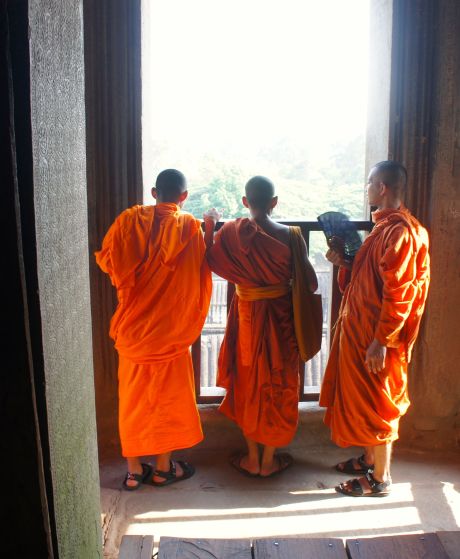I am about to inundate you with images.
I am sorry it’s taken me such a long time to get this post written, but the first three weeks of my new job have been crazy hectic! We had our annual gala dinner fundraising event May 3, so now things are calming down and I have a little more time to breathe.
Let’s travel back in time to Easter weekend…
On Friday we flew from Hong Kong to our layover in Ho Chi Minh City and then on to Siem Reap. We arrived at the hotel too late to go out to dinner, but they let us order room service, which enjoyed on a verandah overlooking the pool. And then we got ready for our first day of touring!
We arranged for someone to drive us to the complex and form one temple to the next in a vehicle called a tuk tuk. It’s like a rickshaw but with a motorcycle dragging the carriage part.

On one of the many tuk tuk rides we took over the two days, we saw these water buffalo–the first I’ve ever seen in real life!
Rather than describe each temple one by one in excruciating detail, I’ll try to highlight some common features, and some distinctive features of each. In general, the temples in the Angkor Wat complex were built by Khmer people from the 9th through the 13th centuries (during Europe’s Middles Ages). The architectural technologies aren’t terrifically advanced (ashlar masonry, corbeled vaults, load-bearing walls), but the sculptural ornamentation is tremendous.
Some of the temples are dedicated to Hindu deities and others to Buddhist ones, depending on the religious persuasion of the king at the time of each construction. Both of these religious traditions were imported to the area by Indian traders, and existed alongside a native Khmer cosmology. Maybe it’s more accurate to say the local gods were absorbed into the greater pantheons of both world religions. Anyway, some of the temples were changed bath and forth from Hindu to Buddhist over succeeding generations of leadership and renovation, so there are interesting examples of ancient iconoclasm marking a shift from one religion to another. (That is to say, sometimes when a king wanted to rededicate a Hindu temple to Buddha, he would have all the faces of Vishnu (for example) chipped off of the existing ornament, or similar).
We saw a great variety of sculptural ornamentation, from very shallow bas relief to full figures in-the-round. There were purely decorative floral or animal motifs, friezes of historical events, friezes of religious events, genre scenes, and imagined portraits. Really a full spectrum of imagery, but all idealized, stylized, and often formulaic.
ARCHITECTURAL FEATURES:
You can see in the photo above that the buildings are stone replicas of wooden structures. In this case the “tile” roof is actually a stone corbeled vault. We also saw blind doors and windows, as well as stone screens in real windows that replicated bamboo or turned wood screens.
Some of the temples show evidence of addition and renovation over time. Some are completely crowded with architectural accretions.
I’m not sure the following counts as an architectural detail, but it’s impressive nonetheless. When these buildings fell out of everyday use, the jungle swallowed them up. The complex wasn’t “rediscovered” until the early 20th century, by which time some temples had been so completely overgrown, they can’t safely be reclaimed from nature. Plus, this looks so cool, I’m not sure you’d want to.

This is a tree essentially swallowing the Ta Prohm temple. We learned that this species is called Spung tree, although wikipedia mentions something called a Strangler Fig, which I think sounds more appropriately descriptive.

I took at least a million photos of the trees here. The impression they give is tremendously eerie. They also make the place seem older than it is, like a forgotten civilization emerging from the mists of time.

These trees are really similar in appearance and behavior to the Chinese Banyans we have in Hong Kong. They can grow on top of anything!
Another element that may not qualify as architectural per se, but is interesting, is the construction of water. Many temples are surrounded by moats so wide they look like lakes.

On the bridge leading over the moat to Angkor Thom. These kneeling figures are holding a long snake whose body forms a balustrade for the bridge.
SCULPTURE:
Some of the most famous images from Angkor Wat are giant, idealized heads. They remind me a bit of Olmec heads, but just because of size and some flatness of the facial features. (I am not suggesting that there was actually some ancient cultural exchange between now-Mexico and now-Cambodia, just noting that there is a minor resemblance).
The highest concentration of giant smiley faces is at a temple called Baphuon.

Also Baphuon, a face in profile. I’ve whimsically made it sepia-toned, just for romance. In real-life, this is the same color as the guys above.
In addition to monumental heads, there are a number of different kinds of relief carving. In fact, in most cases, the temples are completely covered in relief ornament. Every available surface is carved, which is stunning, even overwhelming, for the viewer. There were many examples of very low bas-relief repeating motifs, making some spaces look wallpapered.

This is one of those wallpaper-esque bas reliefs. We both really liked the medallion with two interlocking birds.
Baphuon also had a set of genre scenes, which we didn’t see anywhere else. There were images of hunting tigers and deer, some agriculture with oxen and horses, a chariot rider, and hand-to-hand combat.

Here’s a genre scene with two main figures either dancing or fighting. (Or maybe they’re doing something else?). There are birds flying above them and to the right of the central figure. There’s a giant rodent between his feet, and another climbing the tree at far right. Beneath the tree sits a woman touching her hair, and a human-sib monkey wearing a loincloth a presenting an offering. (It looks like a cup?). So much going on in just one small panel!
One of the decorative elements that the Angkor Wat temple is best known for is its thousands of depictions of Apsaras, which are female spirits of clouds and waters in both Hinduism and Buddhism. They are young, beautiful dancers, and at Angkor Wat, each one is unique, with her own pose and costume and headpiece.
Shall we return to figures in the round (or mostly in the round) for a second? How cool are these elephant columns?!?

It look us awhile to figure out what is going on with the base of their trunks. It’s hard to tell, but the elephants are plucking lotus blossoms out of a pond, and the flowers and streams of water are providing support at the base of the columns.

This is the end of one of the balustrades I mentioned above. It’s called a Naga snake, and it has seven heads. Scary!
RELIGIOUS EXPERIENCE
Many of the temples are still (or again) in use, although in reduced scale and officialdom.

This statue of Vishnu used to be at the central position in Angkor Wat, but when the temple was changed to Buddhism it was moved to an area lower down and off to the side in the same temple. It has been repaired multiple times throughout history.

This, on the other hand, is a giant Buddha in its own separate outdoor pavilion on the grounds of Angkor Thom.
ANGKOR WAT ITSELF
The temple for which the whole complex is named is the largest religious monument in the world.
Angkor Wat is a microcosm of the Khmer universe. It’s surrounded by a moat, which represents the seas of the world. The temple is a series of stepped courtyards and galleries, leading to one central elevated platform. The visitor climbs to the top of a skinny pyramid at the center that represents Meru, the mountain where the Hindu gods live. At the top is a pavilion that used to house an image of Vishnu, who was presiding over vistas across the four cardinal directions. Sometime in the 13th century the temple was converted to Buddhism and the pavilion at its top was enclosed, so you can’t have the original experience, but you can imagine it.
On Easter morning, we got up at 5am in order to visit Angkor Wat at sunrise.
I am so glad we arranged to see the temple this way. My photographs really don’t do it justice–it was truly breathtaking. Plus, we were then able to do hours of touring while the temperature was still manageable. We’d already explored it fairly thoroughly by the time we went to breakfast at 9:30!
We spent hottest part of the day resting at the hotel pool, and went back to see the last of the temples in the late afternoon. We had an amazing curry dinner that evening. It was the most unusual Easter I’ve had to date! And the next morning we had to return to real life. But rather than dwell on that, let’s remember this lovely sight.
Friends, thank you for your patience as I’ve finished up this post! More soon (or maybe not-so-soon…)













Thank you for taking us on such great trips, Rachel!
Jan Anderson
Thank you for reading, Jan!!